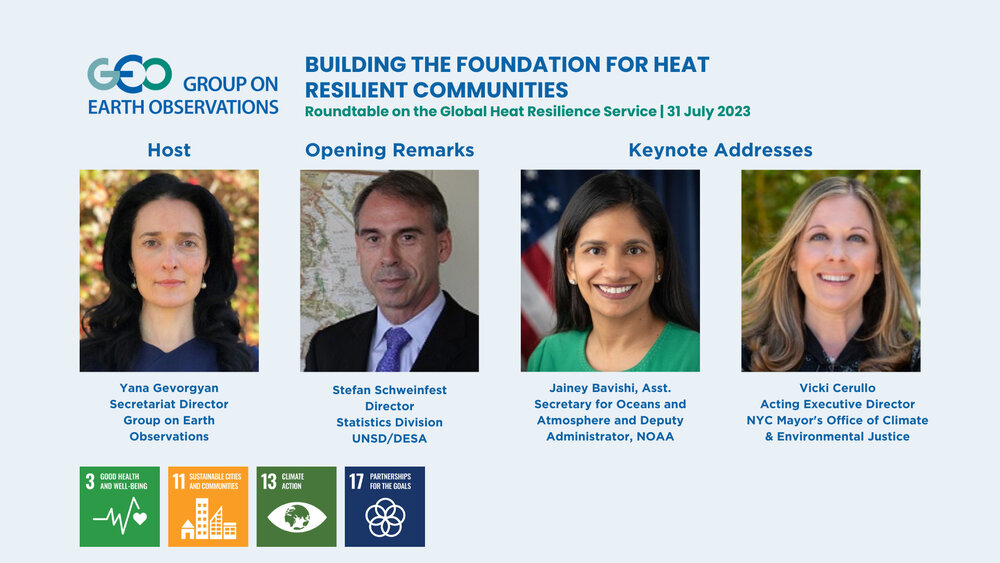Fighting the health risks of extreme heat with data: Expert roundtable on 31 July

It’s hot. That is not up for debate. In recent weeks, multiple records have been broken around the world. The Earth even recorded its hottest average temperature ever on 4 July – 17.18 degrees Celsius / 62.9 degrees Fahrenheit. There were extreme heatwaves in the Southwest United States, Mexico, Southern Europe and China.
This is part of a global trend. Around the world, hot days and extreme weather events are becoming more intense and more frequent. Cities are particularly affected, due to an urban heat island effect that can increase temperatures by up to 20 degrees Celsius. The World Meteorological Organization’s Extreme Heat Advisor John Nairn recently told Reuters, "We're on trend in seeing a rise in global temperatures that will contribute to heatwaves increasing in intensity and frequency,” (Reuters, “Extreme heatwaves to continue through August,” 21 July 2023)
The impacts on health are significant. The elderly, young children, pregnant women, and people with chronic health conditions are particularly vulnerable. Heat also impacts air quality, disease transmission, workplace injury and mental health, and can interrupt essential services such as energy, water and transport. People who work outside are particularly vulnerable.
Although much of the focus is on daytime high temperatures, high temperatures at night can be even more deadly. Studies show that sleep deprivation inflicted by hot weather hits older people and women hardest – the same people who die at the highest rates during heatwaves – and hot nights are associated with high mortality from heat. (Guardian, “How deadly are these heatwaves – and how hot will they get,” 22 July 2023)
Death and illness can be prevented with tailored heat strategies and action plans. However, most cities don’t have comprehensive heat resilience strategies or effective early warning systems because they don’t have the data needed for risk assessment and management.
That is why the Group on Earth Observations (GEO) is convening partners to develop the Global Heat Resilience Service with a goal of providing every urban area in the world with intelligence on the health risks from exposure to extreme heat. These insights will help cities develop plans to adapt to heat and reduce the impact on citizens’ health and local economies.
On 31 July, in New York City, GEO Secretariat Director Yana Gevorgyan will host a side event to the Thirteenth Session of the United Nations Committee of Experts on Global Geospatial Information Management (UN-GGIM), GEO is organizing a roundtable discussion, “Building the Foundation for Heat Resilient Communities.” The focus is the Global Heat Resilience Service, being developed by GEO.
Stefan Schweinfest, Director of the United Nations Statistics Division, will offer opening remarks, emphasizing the role of geospatial and statistical data in understanding climate-related risks and identifying actions toward climate resilience
Jainey Bavishi, Assistant Secretary for Oceans and Atmosphere and Deputy Administrator of the United States’ National Oceanic and Atmospheric Administration, is expected to speak to NOAA’s experience in helping prepare the U.S. for climate and weather extremes, including extreme heat and its impacts.
Vicki Cerullo, acting Director of Climate for the City of New York, will explain how the city of New York has worked to understand the impact of extreme heat and communicating these risks to its residents.
Other featured participants will include Priscilla Idele, Chief of the Population and Development Branch of the United Nations Population Fund andTyler Radford, former Executive Director of the Humanitarian OpenStreetMap Team.
The Global Heat Resilience Service will provide a trusted, free and open- access decision-support tool for all cities around the world. It will use the latest digital tools and leverage the power of cloud computing and Artificial Intelligence to help cities understand when and where extreme heat events will occur, who will be most vulnerable, and what actions can be taken to manage risks.
This work supports the implementation of four of the United Nations’ SDGs: Goal 3 (Good Health and Well-Being); Goal 11 (Sustainable Cities and Communities); Goal 13 (Climate Action) and Goal 17 (Partnerships for the Goals).
Learn more about The Global Heat Resilience Service and our side event to the UN-GGIM meeting on 31 July, Building the Foundation for Heat Resilient Communities.
